As temperatures rise due to a variety of natural and anthropogenic causes, various consequences promote forest fires and further degradation of the earth’s habitability and living conditions. Climate change is the long-term shifts in the earth’s temperature and weather pattern. The temperature has been rising since the Industrial Revolution in the 1700s. Natural causes of rising temperatures include forest fires, shifts in the earth’s position, temperature variations, volcanoes, and so on. The wildlife and forest areas are dying as a result of the rising temperatures. Increased temperatures cause trees to die and dry due to a scarcity of water, which contributes to forest fires. Drought seasons may last longer as temperatures rise, affecting wildlife and humans in a variety of ways.
Human actions, such as careless campfires, are the primary cause of forest fires. Rising temperatures, lightning strikes, etc. are examples of natural causes. Forest fires release a variety of greenhouse gasses, such as carbon and methane, which contribute to the greenhouse effect and, as a result, global warming. Forest fires cause an increase in air pollution due to the smoke and numerous toxins produced. If inhaled, this toxic air can cause death. Let’s look at each of these in more detail.
Forests: Balancing Scale of the Ecosystem
Forests play an important role in maintaining the fresh air levels in the environment. They are essential for both animals and humans. According to the World Wildlife Organization, “Trees purify the air we breathe, filter the water we drink, prevent erosion, and act as an important buffer against climate change.” Forests have many advantages, among them are the following:
- They help in maintaining the balance of oxygen, humidity, and carbon dioxide in the atmosphere.
- Forests and their products are important to a large section of the population. Roughly 1.6 billion people rely on them for their livelihood.
- They are the world’s most diverse systems biologically.
- Many endangered species rely on them for food and shelter.
- Forests protect rivers, ponds, and watersheds, among other things. Thus, provide 75% of the world’s freshwater.
- These are extremely beneficial because they produce clean and cool air, food, provide shelter, and timber, etc.
- They absorb harmful and toxic gasses such as carbon, nitrous oxide, sulfur, and other pollutants, acting as a natural air filter.
- Trees help prevent soil erosion, which helps promote the maintenance of soil fertility.
Rising Temperatures
As the temperature is rising, the earth’s surface and air are also warming up. This is worsening various natural disasters such as floods, storms, droughts, etc. Various natural disasters, such as floods, hurricanes, and droughts, are becoming more severe as a result of this. Even a small increase in temperature is enough to create a shift in our planet’s climate. A warmer climate, according to the NRDC, creates an atmosphere that can gather, retain, and release more water, altering weather patterns so that wet areas become wetter and dry areas become drier.
Harmful effects of rising temperature
These are a few of the effects of rising temperature:
- Adverse weather: Temperature change can make the weather worse. It has the potential to exacerbate a variety of natural calamities, as well as the weather.
- Floods and storms are becoming more common. They pose a threat to property and the environment.
- More moisture in the air encourages the growth of microorganisms as well as harmful insects like mosquitoes.
- Droughts become more common throughout the dry season. This leads to more wildfires, a lack of clean drinking water, dust storms, and an increase in the number of heat waves, among other things.
- Heavier rains cause streams, rivers, and lakes to overflow causing damage to people and property, contaminating drinking water, causing hazardous-material spills, and promoting mold infestation and bad air, according to the Natural Resources Defense Council.
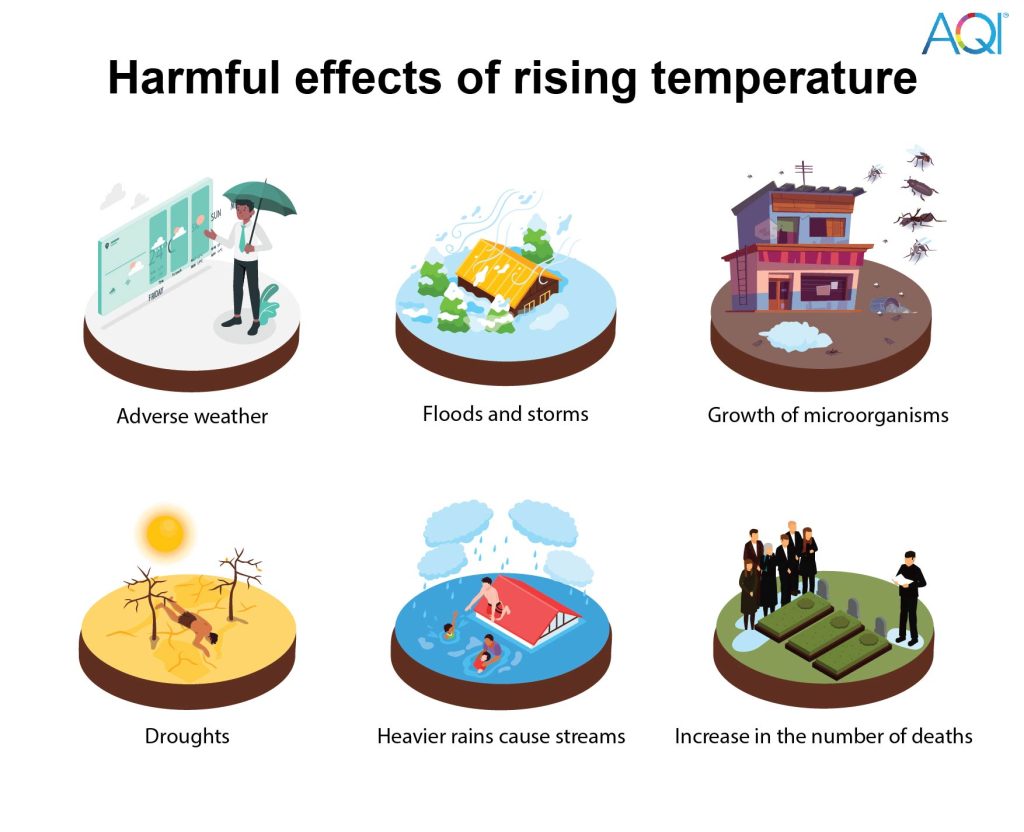
2. Increase in the number of deaths: Climate change and rising temperatures endanger everyone, especially children, the elderly, and the most vulnerable members of society. When the temperature rises, it causes lots of new diseases and deaths. Lower-income groups, who cannot afford air coolers and air conditioners, are more likely to die as a result of excessively hot days when the temperature does not drop even during the night.
Rising Temperature promotes Forest Fires
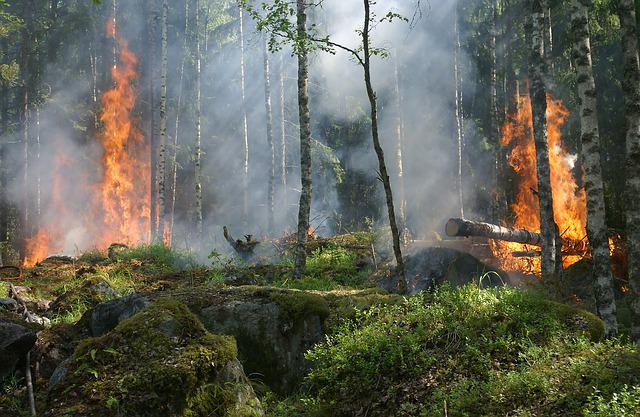
The moisture in the soil dries out as the temperature rises, resulting in combustible trees and vegetation. This causes droughts, rendering the area unfit for irrigation and future usage. Construction of industries, for example, becomes impossible when the soil grows more gritty.
Trees become drier and more prone to catch fire as the temperature rises. Glaciers and ice sheets melt at the same time, leaving forests dryer for longer. Forest fires will become more common in the coming years as the temperature and global warming continue to rise. A temperature rise will affect both the vegetation and the wildlife in a forest. Heat and water scarcity will kill animals, and wildfires will kill even more.
Forest fires are caused by human activities such as careless campfires, which account for 95% of all forest fires. Forest fires will become more common in the future decades, according to the United Nations Environment Programme (UNEP), as a result of climate change and human activity. “Extreme weather events, such as higher temperatures and more droughts, extend fire seasons and raise the risk of fire weather conditions,” according to the UNEP’s Frontiers report. The following are some of the reasons behind the increase in forest fires.
- Patterns of snow and rain have shifted.
- Rising temperatures
- Melting of glaciers and ice peaks
- Shifts in plant communities
- Climate-related changes
- Increased number of lightning strikes
- Earth’s heat
- Reflection rate of sun’s heat
- Deforestation
- The increasing rate of population
- Longer hot season
- Wind patterns, etc.
Types of Forest Fires
The Global Fire Monitoring Center’s (GFMC) Global Wildland Fire Network Bulletin contains the most recent statistics on wildfire consequences: in 2017, 36 fires in protected areas were reported in 19 countries, burning more than 196000 hectares worldwide.
Forest fires can be classified into three categories depending on where they started:
- Crown Fire: This is the most hazardous one of them. The trees are burned from the root to the tip in this type of forest fire, making it more difficult to put out.
- Ground Fire: This is the second most dangerous type of forest fire. When dead compost, wood, and other materials get dry enough to catch fire, the fire burns exclusively on the ground, making it difficult to locate the source of the fire. It has even been known to cause crown fires.
- Surface fires: Litter and garbage are the only things that burn in this type of fire. These are the simplest to put out and cause the least amount of forest damage. This form of fire burns on the surface only.
Causes of Forest Fires
Human activities are the primary cause of forest fires. Forest fires are aggravated by a variety of factors, including:
- Unsupervised Campfires
- Overgrazing by cattle
- Shift cultivation
- Accidental fires by visitors like discarding cigarette buds.
- Some of the natural causes are responsible for forest fires as well. These include:
- Lightning strikes
- Changes in weather patterns
- Bamboo/trees rubbing
- Sun heat levels
Deforestation & role it plays in forest fires
Gradual cutting of trees and forest areas for several purposes like habitation, agriculture, cattle grazing, wood, and timber, among many others is known as deforestation. It happens when new trees are not replaced by the old ones. Deforestation is anthropogenic and can cause forest fires to spread out of control. Forest degraded by deforestation is more likely to catch fire than a dense forest cover. This is because the lush forest cover will act as a wind barrier, preventing the fire from spreading. As the forest cover becomes denser, fewer winds may penetrate, preventing forest fires.
Natural surfaces that reflect more heat than concrete floors have been reduced as a result of deforestation and urbanization. Concrete reflects less heat, resulting in a warmer environment. Trees provide a cool environment and clean air but due to deforestation, the temperature is rising as well.
Forest fires: A threat to the World
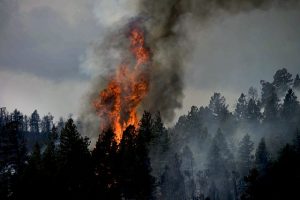
Wildfires are unquestionably harmful to the forest, wildlife, and humans. Uncontrolled fires exacerbate forest deterioration. They have a wide range of detrimental environmental and human health consequences. These are some of them:
- Forest product loss has a significant influence on the livelihoods of those living in the affected areas. For food and shelter, over 300 million people rely on non-timber forest products acquired from forest areas.
- Depletion of wood resources
- Loss of biodiversity, erosion of watershed areas.
- Extinction of plant and animal species
- Declining natural regeneration of forest cover
- Unhealthy living conditions due to increased levels of CO2 in the atmosphere
- Reduction in soil fertility
- Ozone layer depletion
Some examples of forest fires around the world:
- The Simlipal Forest fires (April-March 2021-ongoing), Odisha, India.
- The Black Dragon Fire (1987), China -> burned 18 million acres of forest land.
- The Greek Wildfires (2021), Greece -> burned over 125,000 hectares
- UK Wildfires (26 February 2019 -18 May 2019)
- Croatian Coast fires (2007) -> burning 1,590 km2
- Fires in Al-Suwayda Governorate (May 2020), Syria -> burned 5,550 km2
- The Miramichi Fire (October 1825), New Brunswick -> burned 3,000,000 acres and killed 160-300 people.
- The Great Fire (1845), Oregon -> burned 1,500,000 acres
- Saguenay Fire (1870), Quebec -> burned 964,000 acres
- California Wildfires (2020) -> burned 4,420,301 acres
Possible effects of Forest fires on:
Environment: Wildfires destroy homes, wildlife, habitat, and timber. Forest fires emit huge amounts of pollutants into the atmosphere, including carbon dioxide, nitrogen oxides, hydrocarbons, and others. Air pollution and the greenhouse impact are both exacerbated by these pollutants.
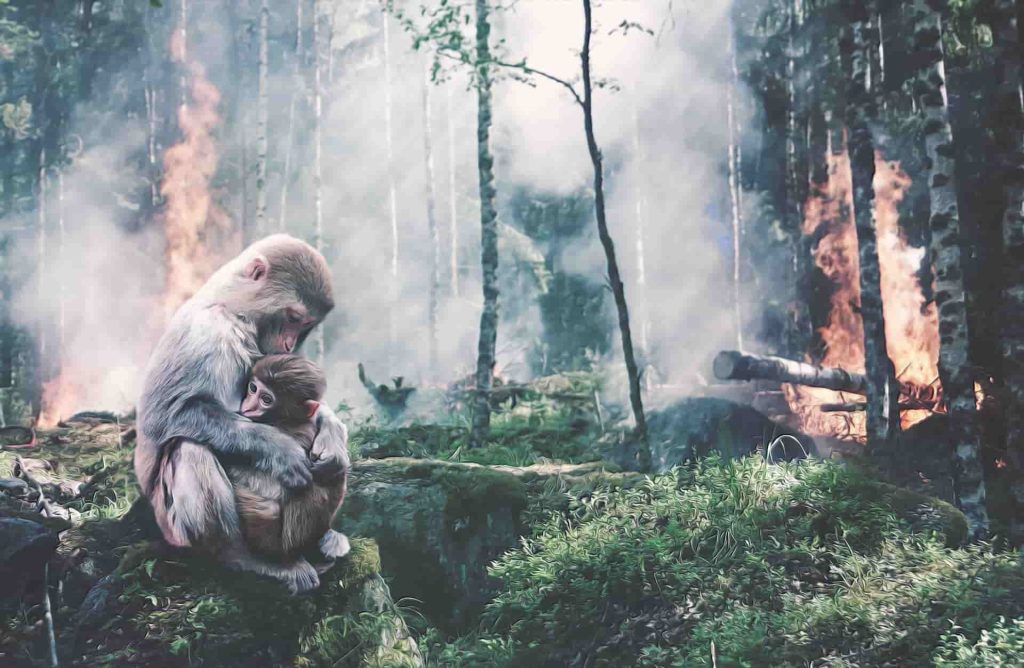
Flora and Fauna: Plants and animals that live in the forests come under the flora and fauna category. Forest fires change the necessities of life that are required to keep them alive. Food, water, and shelter are the three necessities. They cannot survive without these basic necessities.
Humans: Forest fires destroy many natural resources that humans rely on, such as timber, food, etc. Many residential areas near forests are susceptible to fire, rendering them uninhabitable and resulting in property loss. Harmful emissions such as carbon dioxide, carbon monoxide, nitrogen oxide, ozone, and others can cause respiratory disorders (lung cancer, asthma, chest pain, COPD), heart issues, skin burns, and even deaths.
Why are they a major concern?
Rising Temperatures: Temperatures have been steadily rising for decades. Rising temperatures have an impact on many disasters. Heat waves, droughts, floods, and other natural disasters are examples. Climate change and human health are interrelated. As the climate heats, more water is released into the environment, causing weather patterns to shift, enabling hot areas to become hotter and wet areas to become even wetter. Rising sea levels will also result in increased coastal flooding, salinization of water sources, and other effects on humans and the ecosystem.
Forest Fires: A forest fire does more harm than good. Forest fires have several negative consequences, including soil degradation, the loss of life in forests, damage to flora, fauna, and tundra, air pollution, and so on. It also ruins property near the forestation; smoke and harmful fumes have an impact not only on persons but also on the ecosystem. Humans are prone to a variety of respiratory and cardiovascular problems, and exposure to these gasses can result in death. Carbon is a prominent by-product of gaseous emissions, and as carbon is one of the key components causing the greenhouse effect, it contributes to it. Air quality monitoring becomes very important in such areas where there is a forest fire and areas surrounding it.
Tips to prevent Forest Fires
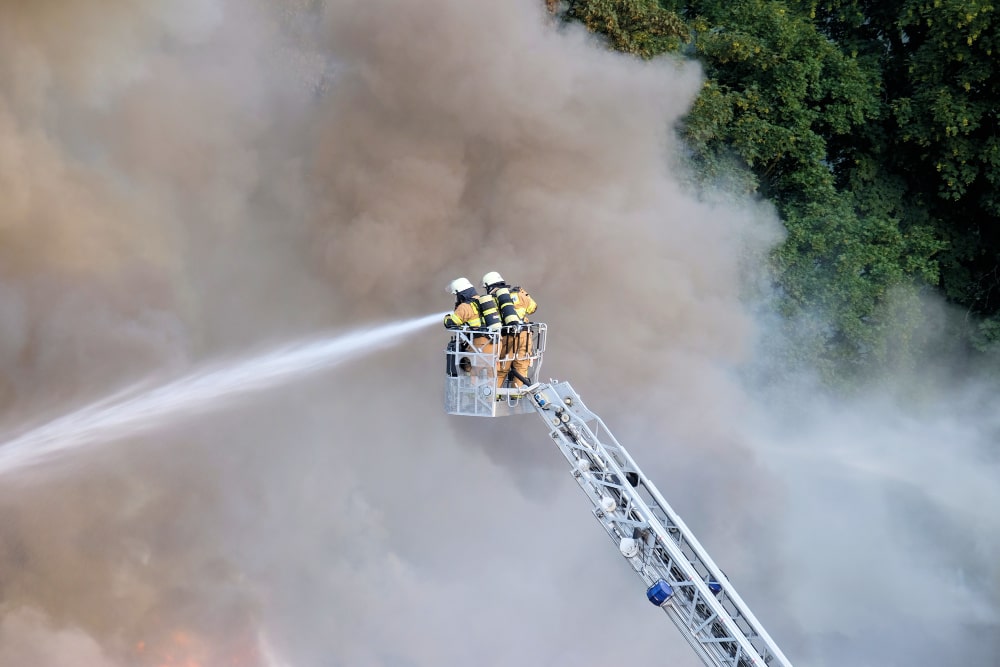
Following are some tips for preventing forest fires, according to the US Department of the Interior:
- Watch the weather and the drought conditions.
- Set your campfire in a wide-open space away from combustible items.
- Choose a flat, open area free of flammable items
- Use a shorter length of wood, stack it in the cleared area, and then start the fire.
- Don’t leave your fire unattended.
- Before you leave, make sure it’s completely out.
- Use at least one bucket of water to put out the fire.
- Stir it until it goes out completely.
- Before you leave, your campfire should be completely cool to the touch.
- Practice vehicle safety.
- Keep dry plants away from sparks.
- Before you use fireworks, be sure you know the rules and restrictions, or think about safer alternatives.
- Burn debris with caution, and never while it’s windy or enclosed.
Conclusion
According to NOAA’s 2020 Annual Climate Report, the combined land and ocean temperature has increased at an average rate of 0.13 degrees Fahrenheit ( 0.08 degrees Celsius) per decade since 1880. The average rate has increased twice since 1981. As a result of climate change and the greenhouse effect, woods become drier and more prone to fires. The melting of ice peaks as a result of rising temperatures has resulted in natural disasters such as floods. The water bodies that serve to avoid forest fires are drying up within the forest region.
Forest fires have an impact on not only species but also the environment and mankind. These contribute to air pollution and cause a variety of ailments in humans, including respiratory and cardiovascular problems, among other things. Wildfires result in property loss, flora and fauna destruction, and toxic gas and smoke emissions. These gasses contribute to the greenhouse effect, which traps heat within the earth’s surface and increases the temperature of the atmosphere. Forest fires have a few advantages in addition to their drawbacks. Soil fertility is improved by fires, which release useful nutrients into the soil.
Forest fires should be avoided by taking preventative steps. Because human activities are responsible for more than 90% of forest fires, precautions must be taken to prevent them. These include avoiding campfires or completely extinguishing them before leaving.
To know the status of active fires in your area, visit https://www.aqi.in/
This post is also available in:
![]() Global
Global ![]() IND English
IND English ![]() UK English
UK English ![]() US English
US English